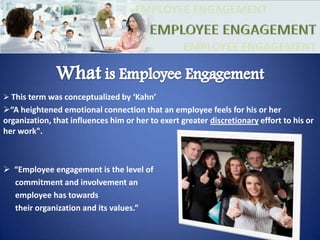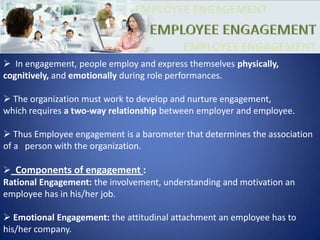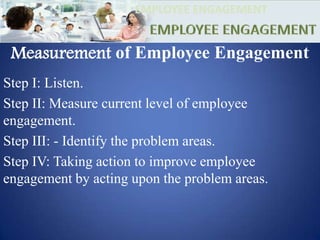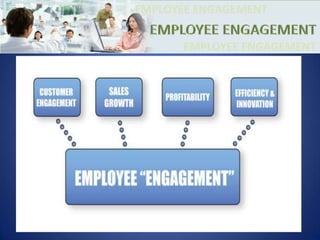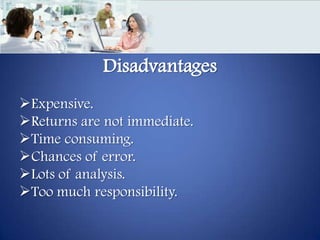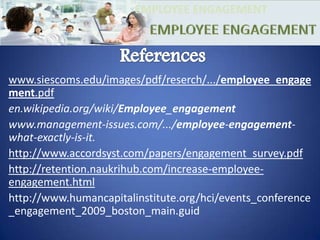Eeployee engagement
- 1. EMPLOYEE ENGAGEMENTEMPLOYEE ENGAGEMENTEMPLOYEE ENGAGEMENTEMPLOYEE ENGAGEMENTBy: Group-A
- 2. EMPLOYEE ENGAGEMENTEMPLOYEE ENGAGEMENTEMPLOYEE ENGAGEMENTGroup -aSonia Agarawal 01NamrataChavan 07AartiDeopure 13 ShantanuGaikwad 19Nikhil Kohok 26Beckes Lopez 30RameshwarMahajan 31RajeshkumarMishra 36PriyankaRane 44SushmitaWakde 60
- 3. What is Employee EngagementVIDEO 1
- 4. EMPLOYEE ENGAGEMENTEMPLOYEE ENGAGEMENTEMPLOYEE ENGAGEMENTWhat is Employee EngagementThis term was conceptualized by ‘Kahn’
- 5. “A heightened emotional connection that an employee feels for his or her organization, that influences him or her to exert greater discretionary effort to his or her work".
- 6. “Employee engagement is the level of commitment and involvement an employee has towards their organization and its values.”
- 7. EMPLOYEE ENGAGEMENTEMPLOYEE ENGAGEMENTEMPLOYEE ENGAGEMENTWhat is Employee Engagement ?Its a step ahead than Employee Satisfaction:Belief in the organization
- 8. Desire to work to make things better
- 9. Understanding of business context and the ‘bigger picture’
- 10. Respectful of and helpful to colleagues
- 11. Willingness to ‘go the extra mile’
- 12. Keeping up to date with developments in the fieldEMPLOYEE ENGAGEMENTEMPLOYEE ENGAGEMENTEMPLOYEE ENGAGEMENT
- 13. EMPLOYEE ENGAGEMENTEMPLOYEE ENGAGEMENTEMPLOYEE ENGAGEMENT In engagement, people employ and express themselves physically, cognitively, and emotionally during role performances.
- 14. The organization must work to develop and nurture engagement,which requires a two-way relationship between employer and employee. Thus Employee engagement is a barometer that determines the association of a person with the organization.
- 15. Components of engagement :Rational Engagement: the involvement, understanding and motivation an employee has in his/her job.
- 16. Emotional Engagement: the attitudinal attachment an employee has to his/her company.EMPLOYEE ENGAGEMENTEMPLOYEE ENGAGEMENTModel of Employee EngagementSay:Speak positively about the organizationStay:Desire to be a member of the organizationStrive:Go beyond what is minimally required
- 17. EMPLOYEE ENGAGEMENTEMPLOYEE ENGAGEMENTEMPLOYEE ENGAGEMENTBELIEFS ABOUT EMPLOYEEENGAGEMENT Engagement is the primary enabler of successful execution of any business strategy
- 18. Engagement is not a short-term initiative
- 19. Engagement must be driven from the top.
- 20. Engagement is all about right fit.
- 21. No one impacts the state of engagement more than an employee’s immediate leader.
- 22. Measuring engagement and demonstrating its business impact is crucial, but it’s only a small part of winning the battle.
- 23. Engagement means reaching the heart.EMPLOYEE ENGAGEMENTEMPLOYEE ENGAGEMENTEMPLOYEE ENGAGEMENTAspects of Employee EngagementThe employees’ unique psychological make up and experience.
- 24. The employers and their ability to create the conditions that promote employee engagement.
- 25. Interaction between employees at all levels.EMPLOYEE ENGAGEMENTEMPLOYEE ENGAGEMENTFactorsVIDEO 2
- 27. EMPLOYEE ENGAGEMENTEMPLOYEE ENGAGEMENTNeed of employee engagement HR practitioners believe that the engagement challenge has a lot to do with howemployee feels about the about work experience and how he or she is treated in the organization.
- 28. In a research survey of more than 50,000 employees at 59 member organizations in 27 countries and 10 industries, done by Corporate Leadership Council, has demonstrated the real bottom-line impact of employee engagement.
- 29. Highly committed employees perform up to 20 percentile points better and are 87% less likely to leave the organization than employees with low levels of commitment.EMPLOYEE ENGAGEMENTEMPLOYEE ENGAGEMENTNeed of employee engagement The “10:6:2” Rule:
- 30. The “10:9” Rule:
- 31. When engagement is below 25 per cent, those companies suffer a negative total shareholder return.categories
- 32. EMPLOYEE ENGAGEMENTEMPLOYEE ENGAGEMENTCategories of Employee EngagementEngaged--"Engaged" employees are builders. Not Engaged--Not-engaged employees tend to concentrate on tasks rather than the goalsActively Disengaged--The "actively disengaged" employees are the "cave dwellers. Actively Disengaged EngagedNot Engaged
- 33. How to achieveEmployee engagement
- 34. EMPLOYEE ENGAGEMENTEMPLOYEE ENGAGEMENTHow to achieve employee engagement
- 35. EMPLOYEE ENGAGEMENTEMPLOYEE ENGAGEMENTGallup StudiesFeedback system put forward by Gallup Studies.
- 36. Basis of survey
- 37. Identification of 12 most effective questions EMPLOYEE ENGAGEMENTEMPLOYEE ENGAGEMENTEMPLOYEE ENGAGEMENT12 Things Important to EmployeesFrom Gallup’s Q12:Knowing what’s ExpectedHaving the Right Materials & EquipmentOpportunity to Do What I Do BestRecognition & PraiseCaring for Me as a PersonEncourages Development
- 38. EMPLOYEE ENGAGEMENTEMPLOYEE ENGAGEMENTEMPLOYEE ENGAGEMENT7. My opinion Counts8. Connection with Mission of OrganizationCo Workers Committed to Quality WorkI have a Best Friend at WorkSomeone Has talked with Me About my ProgressOpportunities to Learn and Grow
- 39. EMPLOYEE ENGAGEMENTEMPLOYEE ENGAGEMENTMeasurement of Employee Engagement Step I: Listen.Step II: Measure current level of employee engagement.Step III: - Identify the problem areas.Step IV: Taking action to improve employee engagement by acting upon the problem areas.
- 40. EMPLOYEE ENGAGEMENTEMPLOYEE ENGAGEMENTIncreasing Employee EngagementEmployees are said to be engaged when they show a positive attitude toward the organization and express a commitment to remain with the organization.Culture
- 41. Continuous Reinforcement of People-Focused Policies Meaningful Metrics
- 42. Organizational PerformanceEMPLOYEE ENGAGEMENTEMPLOYEE ENGAGEMENTIncreasing employee engagementProvide variety.
- 43. Conduct periodic meetings with employees.
- 44. Indulge in employee deployment.
- 45. Communicate openly and clearly.
- 46. Get to know employees' interests, goals, stressors.
- 47. Celebrate individual, team and organizational successes.
- 48. Be consistent in your support for engagement initiatives.EMPLOYEE ENGAGEMENTEMPLOYEE ENGAGEMENTEmployee engagement activitiesEmployee engagement activities / programs1. Picnic and Movie at interval of 2 months.2. A daily column, written by CEO, on the intranet with company announcements / programs etc.3. Update via an overhead paging system, which is used to recognize employees for significant business achievements.4. Employee suggestion systems / quick responses.5. CEO spending time in face to face communication with staff.6. CEO based FAQ questions on company business.7. ONLINE “ask the CEO” mailbox.
- 49. EMPLOYEE ENGAGEMENTEMPLOYEE ENGAGEMENT8. Monthly and Annual staff awards.9. Interaction with disaster management team and emergency management team.10. Problem solving committee.11. Quality assurance committee.12. Conducting soft skills training program as well as required training programs.13. Online real-time tracking of progress. Employees can view company progress towards targets / goals.14. Provide long term strategic vision for business growth.15. Indoor Games as well as Outdoor games, like Chess, Cricket, Badminton etc..16. Celebration of Employees Birthday.
- 51. EMPLOYEE ENGAGEMENT3 Tips on Employee Engagement During a RecessionOpen and honest communication
- 53. HopeEffects: Through opening up a dialogue about the challenging time your business may be facing, will enable you to ensure that to your team:understand the decisions you are making and the reasons for them .
- 54. will be able to identify what these changes mean for them and their roles
- 55. will be better equipped to explain any changes to clients or business partners
- 56. and will undoubtedly be able to share ideas and suggestions they have for managing through tough times.EMPLOYEE ENGAGEMENT
- 58. AdvantagesWhile Hewitt Associates, has just released new data showing the strongest link yet between engaged employees and business success.
- 59. Their analysis of 1,500 companies over a four-year period showed that companies with higher engagement levels had markedly higher total shareholder return. EMPLOYEE ENGAGEMENT
- 60. EMPLOYEE ENGAGEMENTEMPLOYEE ENGAGEMENTEMPLOYEE ENGAGEMENT
- 62. Returns are not immediate.
- 63. Time consuming.
- 66. Too much responsibility.EMPLOYEE ENGAGEMENTEMPLOYEE ENGAGEMENTConclusionBuzz word term for employee communication.
- 67. Positive attitude towards the organization and its values.
- 69. Success of a business.EMPLOYEE ENGAGEMENTEMPLOYEE ENGAGEMENTRecognition of employees.
- 70. Continuous process of learning, improvement, measurement and action.
- 71. We would hence conclude that raising and maintaining employee engagement lies in the hands of an organization and requires a perfect blend of time, effort, commitment and investment to craft a successful endeavor.VIDEO 3
- 73. Thank You.



